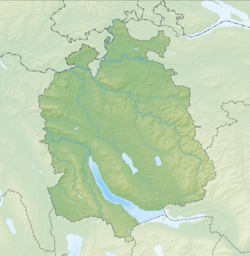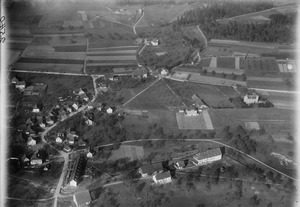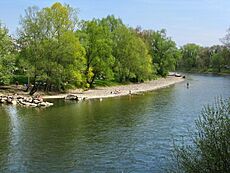Oberengstringen facts for kids
Quick facts for kids
Oberengstringen
|
||
|---|---|---|
 |
||
|
||
| Country | Switzerland | |
| Canton | Zurich | |
| District | Dietikon | |
| Area | ||
| • Total | 2.15 km2 (0.83 sq mi) | |
| Elevation | 413 m (1,355 ft) | |
| Population
(Dec 2020 )
|
||
| • Total | 6,721 | |
| • Density | 3,126/km2 (8,096/sq mi) | |
| Postal code |
8102
|
|
| Surrounded by | Regensdorf, Schlieren, Unterengstringen, Zurich | |
Oberengstringen is a small town, also called a municipality, in Switzerland. It's located in the Limmat Valley, which is a beautiful area in the canton of Zürich. This town is part of the Dietikon district.
Contents
A Look Back: History of Oberengstringen
Oberengstringen has a long history! It was first mentioned in old records way back in the year 870. Back then, it was called Enstelingon. Later, in 1306, its name changed slightly to Obren Enstringen.
Exploring Oberengstringen's Geography
Oberengstringen covers an area of about 2.1 square kilometers (0.8 square miles). A good part of this land, about 23.5%, is used for farming. Forests cover another 26.3% of the area.
Most of the town, about 47.4%, is built up with buildings and roads. A small part, 2.8%, is made up of rivers or other natural areas. The town sits on the right bank of the Limmat river. It's on the road that connects Zürich to Baden, passing through Höngg.
From the 1950s to the 1970s, Oberengstringen grew quickly. It became a popular suburb of Zürich, where many people moved to live.
Nature's Beauty: Werdinsel and Limmatauen
The Limmatauen Werdhölzli is a special protected area of forest and river. Part of it is located right here in Oberengstringen. This area is found between the Limmat river and the Höngg power plant.
It was first protected in 1945. Later, a 1.8-kilometer (1.1-mile) section of the Limmat river and the Werdinsel were restored to a more natural state. This project helped increase the number of different plants and animals, making the river landscape even better.
The Canton of Zurich worked with Oberengstringen and Zürich to renew this part of the river. They made it easier to reach the Limmat and improved the walking path towards the Fahr Abbey. The area was also made wider for people walking and cycling.
Information boards help visitors learn about the local plants and animals. You can cross the river area on a 320-meter (1050-foot) long wooden bridge. This bridge was built using wood from the local forests. The project was finished and shown to the public on September 20, 2013.
People and Life in Oberengstringen
Oberengstringen has a population of 6,721. About a quarter of the people living here are from other countries. The population has grown steadily over the last ten years.
Most people in Oberengstringen speak German, which is about 81.8% of the population. Italian is the second most common language, followed by Serbo-Croatian.
When it comes to age, about 19.6% of the population are children and teenagers (0–19 years old). Adults (20–64 years old) make up 63% of the population. Seniors (over 64 years old) are about 17.4%. Many adults in Oberengstringen have completed higher education.
The town has a low unemployment rate, meaning most people who want to work can find jobs. Many people work in the service industry, like shops, offices, and healthcare. Others work in manufacturing or farming.
In terms of religion, many people in Oberengstringen are either Catholic or Protestant. There are also people who follow other religions or no religion at all.
Here's how the population of Oberengstringen has changed over time:
| year | population |
|---|---|
| 1634 | 61 |
| 1850 | 453 |
| 1888 | 322 |
| 1900 | 416 |
| 1950 | 1,242 |
| 1960 | 4,088 |
| 1980 | 6,154 |
| 2000 | 5,879 |
See also
 In Spanish: Oberengstringen para niños
In Spanish: Oberengstringen para niños






